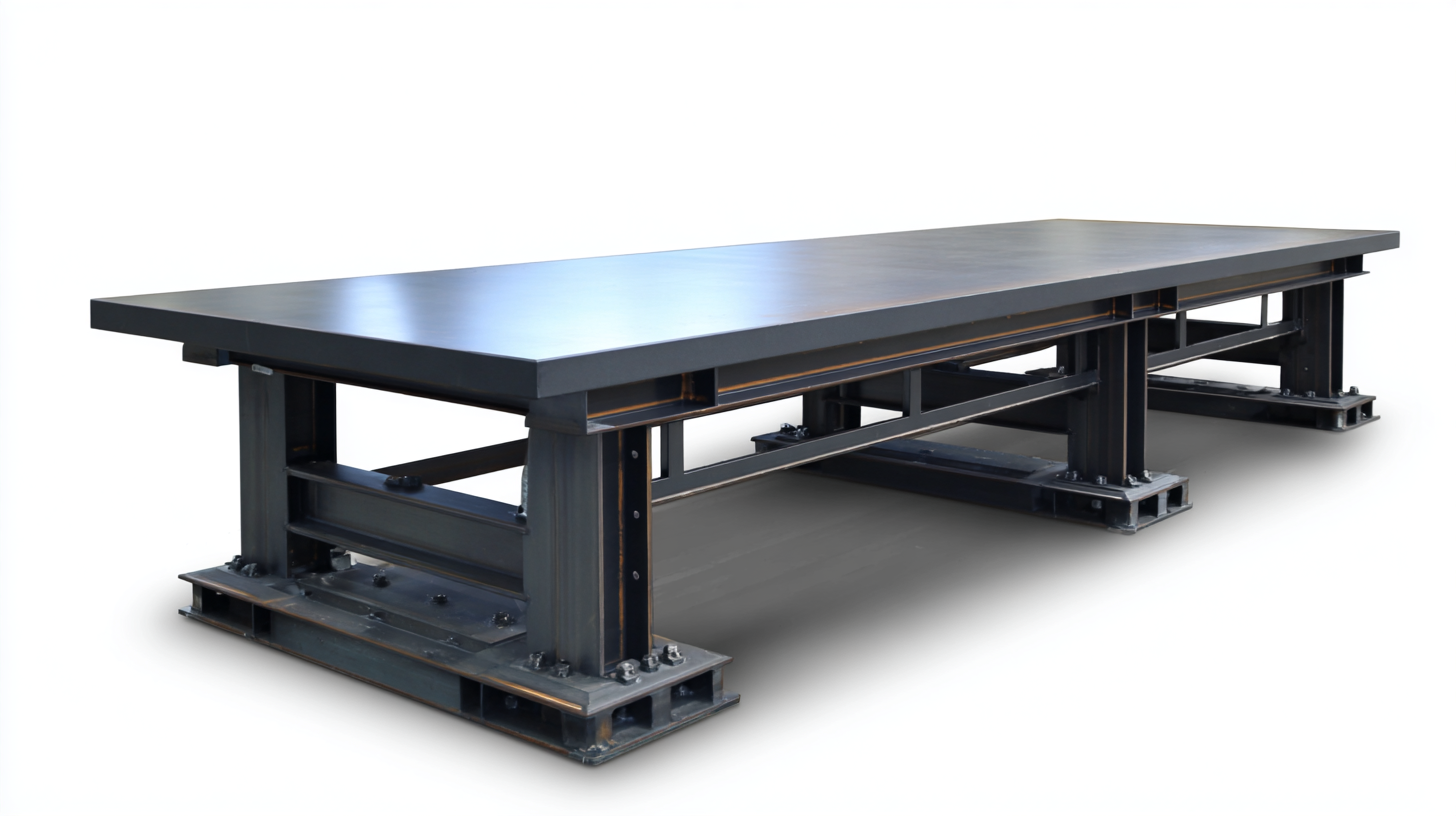Finding Quality Suppliers for Best Industrial Cutting Tables Effective Strategies for Global Buyers
In the ever-evolving landscape of manufacturing, the demand for efficient and precise cutting solutions has led to a significant rise in the global industrial cutting table market. According to a recent report by Research and Markets, the industrial cutting table segment is projected to grow at a CAGR of 5.8% from 2023 to 2028, driven by advancements in technology and an increasing need for automation in production processes. As manufacturers and buyers strive to enhance productivity and maintain competitive advantage, finding quality suppliers for industrial cutting tables becomes paramount. This ultimate guide aims to equip global buyers with effective strategies to identify and partner with reliable suppliers, ensuring they acquire high-quality cutting solutions that meet their operational needs. With the right insights and tools, businesses can navigate the complexities of sourcing industrial cutting tables and ultimately achieve greater efficiency and cost savings in their manufacturing processes.

Identifying Key Performance Indicators for Industrial Cutting Tables Procurement
When it comes to procuring industrial cutting tables, identifying key performance indicators (KPIs) is crucial for global buyers to ensure they are making informed decisions. KPIs serve as measurable values that demonstrate how effectively a company is achieving its operational and strategic goals. For cutting tables, essential KPIs might include precision, durability, and energy efficiency. Buyers should prioritize these indicators to evaluate potential suppliers comprehensively, ensuring the equipment meets their specific production requirements and industry standards.
Additionally, it is vital to assess the reliability of suppliers through KPIs such as lead time, after-sales support, and customer satisfaction metrics. A supplier's ability to deliver on time and provide ongoing technical support can significantly impact operational efficiency. By focusing on these key performance indicators, global buyers can streamline the procurement process, mitigate risks associated with supplier selection, and foster long-term partnerships that lead to sustained productivity and growth. Thus, a strategic approach to identifying and analyzing KPIs not only enhances the procurement of industrial cutting tables but also contributes to overall business success.
Finding Quality Suppliers for Best Industrial Cutting Tables
| Supplier Location | Table Size (ft) | Cutting Precision (mm) | Material Type | Lead Time (weeks) | Customer Rating (out of 5) |
|---|---|---|---|---|---|
| USA | 4 x 8 | 0.05 | Steel | 3 | 4.8 |
| Germany | 5 x 10 | 0.03 | Aluminum | 4 | 4.5 |
| China | 6 x 12 | 0.07 | Composite | 5 | 4.2 |
| Italy | 4 x 4 | 0.04 | Wood | 6 | 4.1 |
Evaluating Supplier Capabilities: Metrics and Data-Driven Approaches
In today's competitive landscape, evaluating supplier capabilities through data-driven approaches is crucial for global buyers seeking quality industrial cutting tables. By leveraging advanced AI and machine learning techniques, businesses can enhance their supplier performance assessments. These technologies allow for the analysis of vast amounts of data, helping procurement teams identify key metrics that signify supplier reliability and performance. Factors such as delivery timelines, quality control metrics, and financial stability can now be quantified, enabling a more nuanced understanding of supplier capabilities.

Moreover, price prediction models utilizing machine learning play a pivotal role in developing effective purchasing strategies. By analyzing historical pricing data and market trends, organizations can forecast future prices for essential materials, such as automotive steel, which directly impacts sourcing decisions. This proactive approach not only mitigates risks associated with volatility in material costs but also empowers businesses to negotiate better contracts with their suppliers. The integration of AI in evaluating suppliers is redefining traditional procurement practices and setting a new standard for efficiency and effectiveness in supplier selection.
Leveraging Technology: How Industry 4.0 Shapes Cutting Table Supply Chains
As the industrial landscape evolves, the integration of
Industry 4.0 technologies is radically transforming how suppliers of cutting tables operate.
With advancements in automation, data exchange,
and IoT technology, manufacturing processes are becoming more efficient.
Smart cutting tables equipped with sensors can provide real-time data on performance metrics, which not only enhances operational efficiency
but also enables predictive maintenance. This shift ensures that manufacturers are less likely to experience
downtime, directly benefiting global buyers who rely on timely delivery and reliability.
Moreover, the rise of cloud-based solutions enhances collaboration within supply chains.
Buyers can access an array of suppliers across the globe, leveraging platforms that allow for seamless communication and real-time updates
on product availability and pricing. This transparency empowers buyers to make informed decisions swiftly. By adopting
smart analytics, suppliers can better understand market trends and customer needs,
ultimately leading to more tailored products and services. The convergence of these technologies not only streamlines procurement processes
but also strengthens the overall agility of supply chains in an increasingly competitive market.

Cost Analysis: Understanding Total Cost of Ownership in Industrial Equipment
When evaluating industrial cutting tables, understanding the Total Cost of Ownership (TCO) is crucial for global buyers. TCO does not only include the initial purchase price; rather, it encompasses a wide range of factors such as maintenance costs, energy consumption, and potential downtime. For instance, a lower-priced cutting table may result in higher long-term costs if it requires frequent repairs or consumes more power than its counterparts. Thus, assessing the overall cost-effectiveness ensures a more informed purchasing decision.
Moreover, factors like training, warranty provisions, and spare parts availability should also be factored into the TCO analysis. Effective suppliers often provide comprehensive training, enabling operators to maximize the equipment's lifespan and efficiency. Warranties that cover potential defects can further safeguard against unexpected expenses. By meticulously calculating these elements, global buyers can identify high-quality suppliers that offer not only competitive prices but also long-term value in their industrial cutting tables, resulting in sustainable operations.
Global Sourcing Strategies: Best Practices for Connecting with Quality Suppliers
When it comes to sourcing quality suppliers for industrial cutting tables, effective strategies are essential for global buyers. According to a report by Deloitte, 79% of companies indicate that supplier relationships significantly impact their overall supply chain performance. This highlights the importance of building a robust network of quality suppliers who can deliver the required standards and innovations.
One best practice for connecting with suppliers includes leveraging digital platforms designed specifically for industry sourcing. Platforms such as ThomasNet and Alibaba provide extensive databases of manufacturers and suppliers, allowing buyers to filter options based on production capabilities, certifications, and reviews. The industry data shows that companies utilizing these platforms can reduce their supplier search time by up to 40%, increasing efficiency and reliability in procurement processes.
Additionally, maintaining transparent communication and establishing standards for quality assurance can further enhance supplier relationships. A McKinsey report notes that organizations that prioritize supplier engagement see an average of 18% improvement in their product quality metrics. By adopting these global sourcing strategies, buyers can ensure they are not only finding quality suppliers but also forming long-term partnerships that drive innovation and profitability in their operations.

